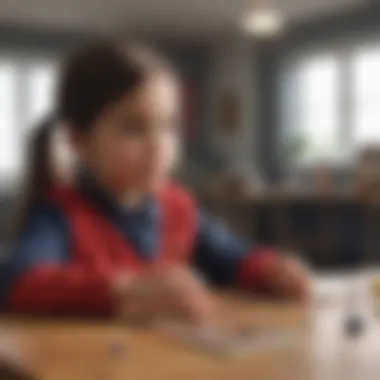Unlock the Secrets: How to Create a Stimulating Learning Environment for Kindergarten


Time Management Techniques
In the realm of kindergartens and their educational realms, navigating time management for optimal learning experiences is paramount. Prioritization methods become key tools in ensuring that each educational activity is structured with the utmost importance placed on cultivating curiosity and intellectual growth in young minds. Task scheduling strategies play a pivotal role in orchestrating a seamless flow of interactive activities tailored to engage and stimulate the inquisitive nature of kindergarten students. Moreover, incorporating effective procrastination prevention tips safeguards against interruptions and distractions that could hinder the learning process.
Introduction
In this incredibly vital section, we delve into the crucial topic of how to make learning an enjoyable experience for kindergarten students. By implementing innovative strategies and engaging techniques, educators can create a learning environment that fosters curiosity and academic growth in young learners. This section serves as the foundation for the subsequent discussions, shedding light on the significance and impacts of infusing fun into the learning process for kindergarteners.
Importance of Fun in Learning
Impact on Engagement
The impact of engagement on the learning process cannot be overstated. Engaging activities and vibrant teaching methods capture children's attention, making the educational journey more effective and enjoyable. By offering stimulating and interactive learning experiences, educators can cultivate a sense of enthusiasm and curiosity in students, enhancing their overall learning outcomes. The unique characteristic of engagement lies in its ability to spark interest and motivation, essential elements in facilitating a positive learning environment for kindergarten students.
Development of Positive Attitudes Towards Education
Fostering positive attitudes towards education is paramount in ensuring long-term academic success. When children associate learning with fun and enjoyment, they are more likely to develop a love for learning and a growth mindset. Encouraging a positive attitude towards education sets the stage for continuous learning and skill development. While the benefits of cultivating positive attitudes are clear, educators must also be mindful of balancing fun with academic rigor to strike a harmonious blend in the kindergarten classroom.
Understanding Kindergarten Learning
Age-Appropriate Teaching Approaches
Tailoring teaching approaches to suit the developmental stage of kindergarteners is essential for effective learning. Age-appropriate methods take into account the cognitive and emotional capabilities of young learners, ensuring that lessons are engaging and comprehensible. By aligning teaching strategies with the age group's needs, educators can optimize learning outcomes and create a supportive educational environment. The key characteristic of age-appropriate teaching approaches is their adaptability and responsiveness to the unique characteristics of kindergarten students.
Cognitive and Emotional Development
Kindergarten marks a critical period for cognitive and emotional development in children. Understanding and nurturing these aspects are vital for promoting holistic growth and academic success. Cognitive development aids in building problem-solving skills and critical thinking abilities, while emotional development fosters resilience and self-regulation. The unique feature of focusing on cognitive and emotional development lies in its long-term benefits for children's overall well-being and academic achievements. Educators play a pivotal role in guiding students through this formative stage, laying the groundwork for a successful educational journey.
Engaging Activities
Engaging activities play a pivotal role in creating a dynamic and effective learning environment for kindergarten students. By incorporating interactive and stimulating activities, educators can foster curiosity, engagement, and holistic development in young learners. These activities serve as essential tools to capture children's attention and enhance their cognitive and social skills, making the learning process more enjoyable and impactful.


Interactive Learning Games
Digital and Physical Games
Digital and physical games offer diverse yet complementary benefits to the overall learning experience. Digital games, through interactive interfaces and engaging content, help in the development of hand-eye coordination, problem-solving skills, and tech literacy among children. Physical games, on the other hand, promote physical activity, social interaction, and teamwork skills. The blend of digital and physical games ensures a well-rounded approach to learning, catering to different learning preferences and enhancing overall engagement and retention.
Role-Playing and Imagination Exercises
Role-playing and imagination exercises are powerful tools for fostering creativity, empathy, and communication skills in kindergarten students. Through role-playing, children can immerse themselves in various scenarios, enabling them to explore different perspectives, develop interpersonal skills, and enhance their emotional intelligence. Imagination exercises stimulate innovative thinking, boost confidence, and encourage self-expression, enriching the learning journey with imaginative and experiential elements.
Art and Creativity
Art and creativity are integral components of a well-rounded educational experience for kindergarten students. Craft projects introduce children to hands-on activities that promote fine motor skills, creativity, and decision-making abilities. Music and movement activities tap into children's natural inclination towards rhythm and expression, fostering emotional development, self-regulation, and appreciation for the arts. Both art forms provide avenues for self-expression, exploration, and skill acquisition, enriching the educational landscape with creative and sensory stimulation.
Craft Projects
Craft projects offer children a creative outlet to express themselves, enhance their motor skills, and unleash their imagination. By engaging in hands-on activities like drawing, coloring, and crafting, students can develop patience, attention to detail, and innovative thinking. Craft projects not only cultivate artistic abilities but also instill a sense of accomplishment and pride in young learners, promoting holistic development and creative exploration.
Music and Movement Activities
Music and movement activities leverage the inherent rhythm and movement abilities of children to enhance their emotional expression, physical coordination, and cognitive development. Through singing, dancing, and playing musical instruments, students can explore their creativity, improve their listening skills, and foster a love for music. These activities encourage self-expression, social interaction, and coordination, nurturing a well-rounded approach to learning that integrates arts, creativity, and holistic development.
Outdoor Exploration
Outdoor exploration offers kindergarten students a unique opportunity to connect with nature, engage their senses, and develop an appreciation for the environment. Nature walks expose children to the wonders of the natural world, encouraging curiosity, observation skills, and a sense of exploration. Gardening and sensory activities enable hands-on interaction with the environment, fostering responsibility, patience, and connection to the earth. By incorporating outdoor experiences into the learning curriculum, educators can enhance Gardening and sensory activities provide children with a sensory-rich environment to explore, engage with nature, and connect with the earth. Through gardening, students learn about Furthermore, sensory activities stimulate children's senses, develop their motor skills, and encourage scientific exploration.
Personalized Learning
Personalized learning plays a crucial role in the educational development of kindergarten students. By tailoring lessons to individual interests, educators can create a more engaging and effective learning environment. This approach focuses on catering to the unique needs and preferences of each student, ensuring that the content is relatable and meaningful to them. One of the key benefits of personalized learning is that it helps students stay motivated and interested in the material, leading to better retention and understanding. It also fosters a sense of independence and autonomy in young learners, as they become active participants in their own education. However, it is essential for teachers to strike a balance between catering to individual interests and covering essential educational content to ensure comprehensive learning outcomes.
Tailoring Lessons to Individual Interests
Incorporating Student Preferences


Incorporating student preferences involves aligning the lesson content with the specific interests and inclinations of each student. This personalized approach ensures that the material resonates with the students on a personal level, making learning more enjoyable and relevant. By incorporating elements that students are passionate about, educators can increase engagement and motivation, leading to better learning outcomes. One key characteristic of incorporating student preferences is that it encourages active participation and enthusiasm in the classroom. Students feel more connected to the material when it reflects their interests, resulting in a deeper level of understanding and retention.
Utilizing Diverse Learning Styles
Diverse learning styles refer to the various ways in which students prefer to receive and process information. By recognizing and utilizing these different styles, educators can create a more inclusive and effective learning environment. This approach acknowledges that each student has unique strengths and preferences when it comes to learning, and aims to accommodate these differences. One of the primary advantages of utilizing diverse learning styles is that it promotes equity and accessibility in education, catering to a broad range of students with varying needs. However, one challenge of this approach is the need for teachers to adapt their teaching methods to suit different learning styles, which can require careful planning and resources.
Hands-On Experiences
Hands-on experiences are an essential component of experiential learning, allowing students to engage with concepts in a tangible and meaningful way. By providing opportunities for experimentation and real-world applications, educators can enhance comprehension and retention among kindergarten students. One key characteristic of hands-on experiences is that they promote active learning and critical thinking skills. When students are actively involved in activities such as experiments and science projects, they develop a deeper understanding of the subject matter and how it relates to the world around them.
Experiments and Science Activities
Experiments and science activities are valuable tools for facilitating hands-on learning experiences in kindergarten classrooms. These activities encourage students to explore scientific concepts in a practical and engaging manner. One of the key benefits of experiments and science activities is that they foster curiosity and inquiry among students, prompting them to ask questions and seek answers through experimentation. Additionally, these activities help develop problem-solving skills and promote a positive attitude towards science and discovery.
Field Trips and Visits to Local Places of Interest
Field trips and visits to local places of interest offer opportunities for experiential learning outside the classroom setting. By exposing students to real-world environments and experiences, educators can enrich their learning experiences and provide context to academic concepts. One key characteristic of field trips is that they stimulate curiosity and sensory engagement, allowing students to connect theoretical knowledge to practical applications. However, organizing and implementing field trips can be logistically challenging and require careful planning to ensure safety and educational value.
Educator Strategies
Educator strategies play a pivotal role in shaping the kindergarten learning experience. By focusing on tailored approaches, educators can create a dynamic and engaging environment that fosters curiosity and academic growth in young learners.
When implementing educator strategies, it is crucial to consider the diverse learning styles and preferences of students. By incorporating a variety of teaching methods, educators can effectively engage students and enhance their comprehension and retention of information.
Moreover, educator strategies also emphasize the importance of fostering a collaborative learning environment where students can interact, learn from each other, and develop crucial social skills. Encouraging collaboration among students not only enhances their academic performance but also cultivates a sense of community and mutual respect within the classroom.
In addition, educator strategies advocate for the use of positive reinforcement to motivate students and celebrate their achievements. By providing encouragement and support, educators can instill confidence in students and inspire them to strive for excellence in their academic pursuits. Through a combination of collaboration, tailored approaches, and positive reinforcement, educator strategies contribute significantly to making learning fun and rewarding for kindergarten students.
Encouraging Collaboration
Group Projects
Group projects play a fundamental role in fostering collaboration and teamwork among kindergarten students. By working together on shared tasks and projects, students learn to communicate effectively, delegate responsibilities, and problem-solve collectively. The key characteristic of group projects lies in their ability to promote cooperative learning and peer engagement.


Group projects are a popular choice in kindergarten education as they encourage students to develop critical thinking skills, creativity, and leadership qualities. They provide a platform for students to showcase their individual strengths while learning from their peers' diverse perspectives and ideas.
A unique feature of group projects is their capacity to enhance students' social and emotional development. By collaborating with their classmates, students cultivate empathy, patience, and resilience, essential skills that extend beyond the academic realm. While group projects offer numerous benefits in promoting collaboration and holistic growth, they may also present challenges related to task allocation and group dynamics.
Peer Learning Opportunities
Peer learning opportunities complement traditional teaching methods by encouraging students to learn from each other's experiences and knowledge. In a peer learning environment, students take on the role of both teacher and learner, leading to a symbiotic educational exchange.
The key characteristic of peer learning lies in its student-centered approach, where learners play an active role in constructing their knowledge through interactions with their peers. This method underscores the value of cooperative learning, empathy, and mutual support among students.
Peer learning opportunities are a beneficial choice for kindergarten education as they promote a sense of inclusivity, respect, and shared responsibility among students. By actively engaging in peer-to-peer teaching and learning, students not only reinforce their understanding of concepts but also develop strong communication skills and self-confidence.
A unique feature of peer learning opportunities is their ability to create a supportive learning community where students feel empowered to seek help, provide feedback, and collaborate on projects. While peer learning offers a student-driven and interactive approach to education, it may require careful structuring to ensure all students actively participate and benefit from the experience.
Assessment and Feedback
In the realm of education, assessments and feedback play a pivotal role in gauging a child's progress and understanding. This section delves into how these elements contribute to creating an enriching learning experience for kindergarten students. Through assessments, educators can evaluate the effectiveness of their teaching methods and tailor lessons to meet individual needs effectively. Feedback, on the other hand, provides valuable insight into a child's learning journey, offering praise for achievements and guidance for improvement.
Constructive Feedback
Encouraging Growth Mindset
Encouraging a growth mindset is crucial in fostering a positive attitude towards learning. By promoting the belief that intelligence and abilities can be developed through effort and perseverance, educators can empower young learners to embrace challenges and see failures as opportunities for growth. This article emphasizes the importance of instilling a growth mindset in kindergarten students to nurture resilience and a passion for learning.
Recognizing Effort and Improvement
Recognizing effort and improvement is essential in motivating students to strive for excellence. By acknowledging and celebrating the progress of each child, educators can boost confidence and self-esteem, creating a supportive learning environment. This section highlights the significance of appreciating the journey of learning, not just the final outcomes, to inspire continued growth and development.
Non-Traditional Evaluation Methods
Innovative assessment methods offer alternative ways to evaluate student progress beyond traditional tests and grades. This section explores the benefits of incorporating non-traditional evaluation approaches in kindergarten classrooms to provide a holistic view of children's abilities and skills.
Portfolios and Project-Based Assessments
Portfolios and project-based assessments allow students to showcase their learning through tangible examples of achievements and creative projects. By engaging in hands-on tasks and long-term projects, children can demonstrate their understanding and skills in a more authentic and comprehensive manner. This text highlights the value of portfolios and project-based assessments in capturing the depth and breadth of student learning experiences.
Observational Assessments
Observational assessments involve keenly observing students in various learning situations to gather insights into their progress and behaviors. By closely monitoring how children interact, solve problems, and engage with tasks, educators can gain a nuanced understanding of their strengths and areas for improvement. This portion discusses the advantages of using observational assessments to tailor teaching strategies and provide targeted support for each student's educational journey.



